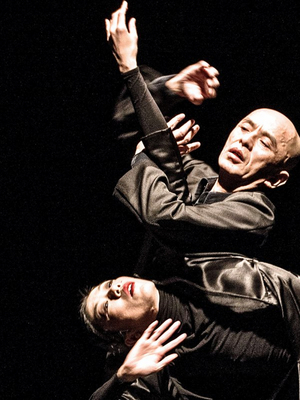Review: TRISTAN AND ISOLDE at the Coronet Theatre
A searching dance adaptation of Wagner's masterpiece

![]() Richard Wagner had many strong ideas when it came to music, especially his operas.
Richard Wagner had many strong ideas when it came to music, especially his operas.
One of the central ones was the idea of the Gesamtkunstwerk, of being in control over everything, from the libretto and the music to the early productions. Taking that from a performance is done at great peril when seeking a truly Wagnerian experience - and Japanese choreographer and dancer Saburo Teshigawara's adaptation does it with some mixed results.
Reducing the runtime to a mere 60 minutes and concentrating on excerpts that focus on the love story between the titular characters, Teshigawara's dance version of Tristan is a curious beast indeed. But is it worth it?
As one would expect from the iconic Teshigawara, the choreography is strong. There is no doubt that he himself, at the proud age of 68, is still an impressive dancer and choreographer. Paired with Rihoko Sato, he delivers a performance that is well worth the runtime. Wearing simple black costumes, they have a wonderful chemistry on stage as they enact some of the opera's most memorable moments.
Teshigawara portrays a lot of large, wavelike motions, building together a chorus of movements indicating passion, only to be occasionally interrupted by touches of irregular twitches, hinting at the underlying difficulties of the fateful love story. Sato, meanwhile, has smoother, rounded movements to accomplish. Her face always carries some of the necessary tragedy in her eyes. It's really beautiful to look at.
Where the dance adaptation falls apart a little is at the drawing board. Of course it is true that it's impossible to dance the full runtime of Tristan und Isolde - but how does one deal with the cuts? In the first half of the production, the music jumps all over the place. We hear the overture; then there's a fade-out followed by a fade-in to the next bit, and this occurs numerous times, always taking the audience out of the action.
As Wagner insisted, we need the Unendliche Melodie for the piece to be effective - the never-ending melody, or the "forever modulating melody". But how is it forever modulating when it's interrupted every few minutes and starting at an entirely different point in the plot?
Another issue with this editing is that the scenes selected for the portrayal are all centred around Tristan and Isolde's love affair. Fair enough: the opera's central theme is endlessly unsatisfied longing, but it does mean that we get the repetition of the yearning and longing themes in the music far too often over the course of just an hour. This might be great for fans of Wagner whose hair stands erect like a frightened hedgehog at the sound of the first notes of the main theme, but for others it might be considered a bit repetitive.
These factors considered, it's important not to neglect that this is primarily a dance performance, and as such, it is more powerful than the issues surrounding Wagner's dream suggest. The choreography is stunning, and coupled with gorgeous lighting - designed by Teshigawara himself and executed by Thomas Leblanc - it produces some scenic magic that is wonderful to look at, and therefore makes this production of Tristan and Isolde well worth it.
Tristan and Isolde is at the Coronet Theatre until 10 June.
Photo Credit: Mariko Miura
Reader Reviews

Videos

